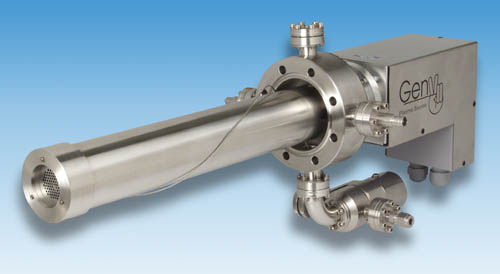Ion Source
Ion source
The ion source specifications can be found elsewhere. The principle of operation is based on the electron cyclotron resonance (ECR) effect. The plasma is generated by evanescent coupling of microwaves at 2.45 GHz using a 250 W power supply, in presence of an inert gas confined inside an alumina cup. The plasma is further enhanced by the action of a magnetic quadrupole placed around the alumina cup. Ions are finally accelerated by a set of grids (anode and extractor), to provide a broad beam with a divergence of +/- 15 deg.
Figure 4: Plasma Source
The source can be configured to operate in several distinct modes: atom source, ion source and atom/ion hybrid source. However, only the ion source mode is used in our setup. The plasma source covers a complete energy range from neutral thermal atoms to ions above 1500 eV. The shape of the beam and the current density can be altered with several ion beam optics (Molybdenum). The typical working distance d is 150 mm. However, it could be varied by 100 mm (using a bellows system), resulting in a variation of the flux density by a factor 4. A large range of combinations of ion current, energy, and flux can be reached, therefore, allowing a systematic study of the ion bombardment process.




